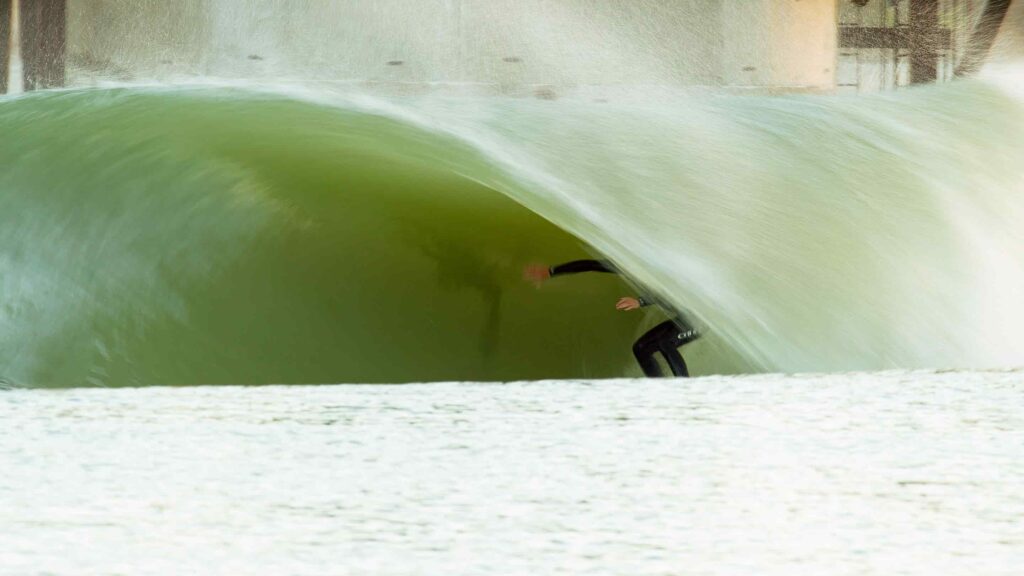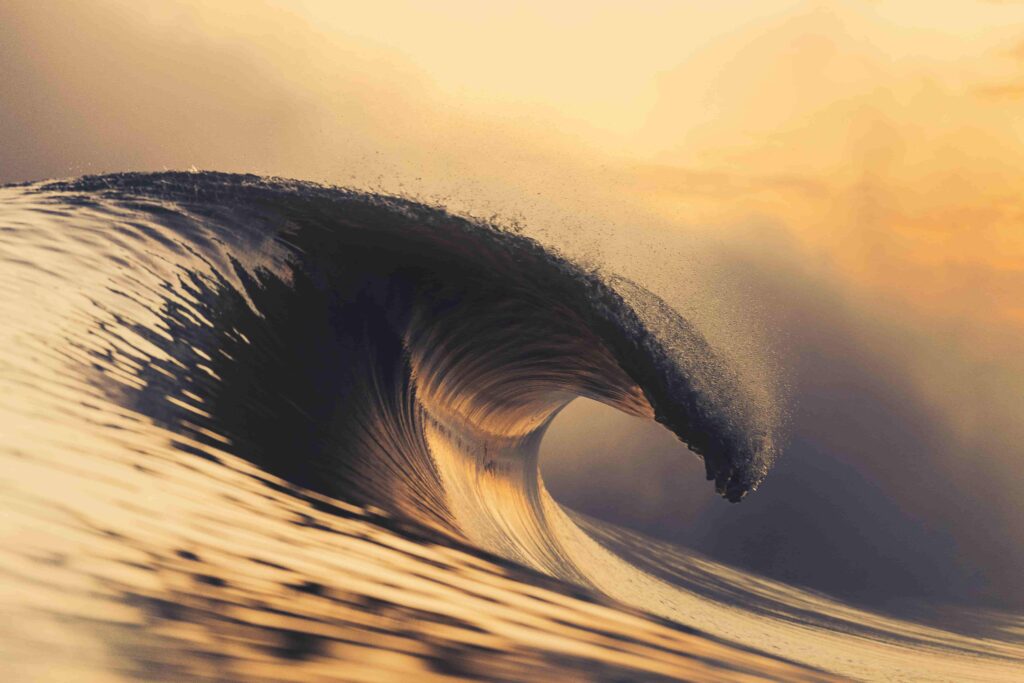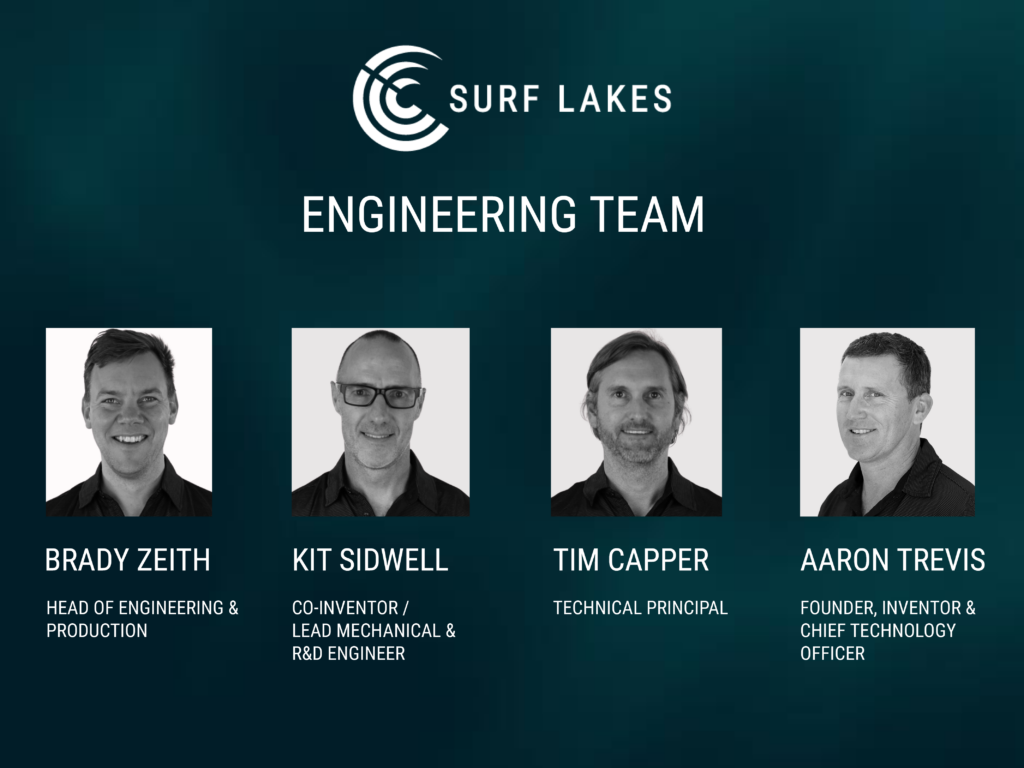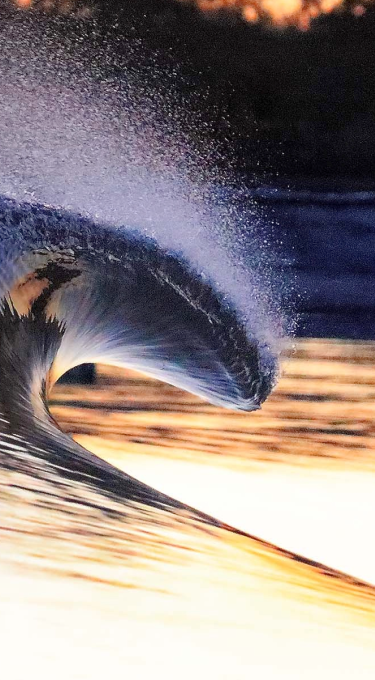
SURF LAKES’ ENERGY EFFICIENT DESIGN
Surf Lakes’ energy-efficient design uses water displacement technology to create waves, which is vastly more efficient than some existing methods of moving water
At Surf Lakes, despite the giant plunger dominating the scene, it’s the waves that take centre stage.
They are what all other experiences at the park centre around: the thrills and spills, the progression, the joy, performance and spectacle. The waves enable all of this, and as a result, powerful, ocean-like waves are essential for a surf park to thrive.
Every surfer at some stage will have experienced the frustration of underpowered waves. Low-quality waves make surfing a chore, while high-quality waves make surfing a joy. While wave quality is dictated by a complex combination of factors (to be covered in detail in an upcoming blog), a critical ingredient is the energy that the wave itself carries with it.
In a time when energy use is a hot topic, one rule must first be recognised:
You can’t get more energy out than you put in!

Above: Sheldon Simkus tapping into some Surf Lakes slab energy
Wave Generation Methods and Energy Consumption
A key understanding is that a wave’s energy is inextricably linked to the surf park’s energy consumption. Supply too little, and the wave itself will be starved of power. It’s like jumping into a family sedan but expecting sports car performance – the power just isn’t there! So, to create an exciting wave, sufficient power must be supplied. Claiming rock-bottom power consumption could be interpreted as confessing to underpowered waves. How can they be powerful if you haven’t put the energy in?
But just supplying enough energy does not guarantee a powerful result. That energy must make it into the waves without losing too much along the way. This now becomes a question of efficiency. In the worst case, pouring energy into an inefficient system can still lead to an underwhelming result – a place some varieties of wave technology find themselves. That energy needs to be directed with purpose and managed efficiently. This is where the mechanism for wave generation becomes essential to the equation.
Surf Lakes’ energy-efficient design uses water displacement technology to create waves, which is vastly more efficient than the “pneumatic caisson” method of moving water. Surf Lakes’ wave-making device is lifted and then dropped, with the downward plunge imparting its energy into the water to create a swell using gravity. This process is very efficient, as evidenced by what happens immediately after the machine is turned off. As soon as the energy supply is cut off, the bobbing oscillation of the machine rapidly decays to zero. This means the energy of the moving machine is directly transferred to wave energy.
The Benefits of Compressed Air
But we’re getting ahead of ourselves here – that’s just the result. Let’s review the rest of the system to make sure electricity has a clear pathway to becoming wave energy. At the beginning of the process, Surf Lakes’ system uses electric air compressors. These are centrifugal machines- the most efficient method of compressing the volumes of air required. Several compressors are installed in this system, affording the choice of how many are running at any one time. Combined with each compressor’s adjustable flow, this creates the ability to supply what the current wave setting demands without excess. The compressed air is then stored in air tanks (like a big battery), ready to make waves at the press of a button. Conventional systems usually cool the compressed air, removing the heat that results from compression. Surf Lakes retains the heat, rather than losing that precious energy from the system. This has a significant effect on energy efficiency compared to common factory compressed air usage. Just like a bike pump, the compressors heat up during use. The lake water is used to cool the compressors and return that warm water to the lake. So, no energy is wasted during the process.

Above: Surf Lakes’ unique and energy-efficient system for wave generation
Stored Energy
The air tanks also have another role to play as an energy storage system. Other wave-generating technologies don’t store energy, they consume power on demand only when the waves are being made and mistakenly purport this as a benefit. The efficiency issue with some other technologies is that when the machine springs into action to create a set of waves, the motors must directly supply the full energy that is being imparted to the waves. This requires the equipment to be large, as it is sized to meet the peak supply requirement. In addition, electricity demands will fluctuate wildly, from zero at one minute and spiking to maximum the next. In regions where electricity suppliers charge based on peak draw figures, this can be costly.
In contrast, Surf Lakes energy-efficient design runs on a 100% duty cycle. This means that the compressors run at a largely constant rate, without stopping and starting. This spreads lower energy use over a longer period, reducing the size of the machinery and removing the large spikes in power draw. This is how these compressors are designed to be operated (and regularly are in industries like mining and processing facilities), where they faithfully perform 24/7 service, day in, day out.
Back to the energy storage – how does this help Surf Lakes’ machine? Once the tanks of air are full, there is a large amount of accumulated potential energy on hand to make waves with. Compressed air is one of the most flexible methods of applying power – a small amount can be released for small waves, or a larger amount can be let fly with an impressive display of force. Other technologies may be limited in their ability to make bigger waves without an economical way of delivering the required energy. The only option in that instance is to install even bigger motors, which pushes the limits of cost and commonly available equipment. Compressed air affords Surf Lakes the luxury of being able to scale up to bigger waves, thanks to the accumulation system and the ability to deliver the required power. Surf Lakes already offers the largest waves in the industry, so it’s exciting to know there is still plenty of headroom to go bigger.

Above: Energy well spent (captured by Rambo Estrada during a Surf Lakes demonstration day)
The Pipeline
Moving on in the compressed air system, pipework delivers the air from the shoreline, beneath the lakebed, out to the middle of the lake. The pipes are appropriately sized, meaning low air velocity and negligible friction losses. Once again, the beauty of compressed air is that it can easily convey as much energy as needed all the way out to the middle of the large lake, removing the need for high-voltage motors to be anywhere near the water.
The centre of the lake is where that energy gets turned into waves. The compressed air is used to drive a hydraulic system and lift the 1400-tonne central wave device. The hydraulic system is water flooded, water lubricated and powered by oil-free compressed air – meaning no contamination risks! This provides extremely low-friction movement with very low mechanical losses, especially considering the size of the machine. The 360-degree concentric nature of the lake dictates that the radial forces cancel each other out, so the machine oscillates straight and true. The stored air is used up over the set of waves (typically 5), and the settling time between sets is used to recharge the air storage for the next set.
Above: Learn more in our Tech Explainer video, where Kit Sidwell discusses energy efficiency
The End Product
Which brings us back to the waves, fed with energy that has made it through the system largely intact, and in turn marching outwards to give their energy to the next group of frothing surfers.
Due to the concentric (and uniform) rings of wave energy that pulsate outward from the machine, each reef break receives the same amount of energy. It’s the bathymetry (or shape of these reefs) that dictates whether this swell energy breaks in a slow, peeling wall or a heaving, hollow tube. This area is its own fascinating topic of conversation, so it will be covered in more detail in the next blog post.
If you’ve ever ridden a wave, you’ve no doubt felt that exciting moment of weightlessness where the wave picks you up and takes you on board for the ride. Your paddling arms are no longer required, as you tap into a greater force. When harnessing the speed and power on offer, the better the wave, the more effortless the surfing feels. It’s a wonderfully addictive experience that’s hard to explain, and even harder to bottle up. But we think it’s a worthy endeavour. And that’s why Surf Lakes strives to create the best quality surf park waves with the most efficient means available.


